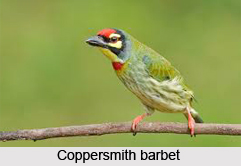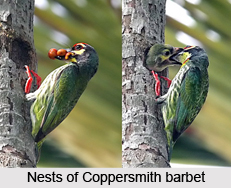 Coppersmith Barbet, Crimson-Breasted Barbet or Coppersmith is an Indian Bird that bears a scientific name "Megalaima Haemacephala" concentrated in the Asian countries and the Indian States.
Coppersmith Barbet, Crimson-Breasted Barbet or Coppersmith is an Indian Bird that bears a scientific name "Megalaima Haemacephala" concentrated in the Asian countries and the Indian States.
Behaviour of Coppersmith Barbet
Coppersmith Barbet is a bird with crimson forehead and throat which is best known for its metronomic call that has been likened to a coppersmith striking metal with a hammer. Coppersmith Barbet is a resident found in the Indian subcontinent and parts of Southeast Asia. Like other Barbets, they chisel out a hole inside a tree to build their nest. They are mainly fruit eating but will take sometimes insects, especially winged termites.
Concentration of Coppersmith Barbet
Coppersmith Barbet is a species of barbet found to overlap in range with several larger barbets in most of South Asia. In the Western Ghats Mountain Range in India, it partly overlaps with the Malabar barbet which is of a very similar size but having a more rapid call. The red forehead, yellow eye-ring and throat patch with streaked underside and green upperparts, it is fairly distinctive. Juveniles are duller and lack the red patches. The sexes are alike. Sri Lankan form of Coppersmith Barbet has more black on the face, more red on the breast and darker streaks on the underside.
Nests of Coppersmith Barbet
During the nesting season, the wear and tear on the feathers of coppersmith barbet can cause the plumage of the upper back to appear bluish. Coppersmith Barbets are found to be basal in phylogenetic analyses. Most of the remaining Asian species are more recent in their divergence and speciation. Throughout their wide range, Coppersmith Barbets are found in gardens, groves and sparse woodland. Habitats with trees having dead wood suitable for excavation is said to be important. In the Palni Hills of southern India it is said to occur below 4000 feet. In the Himalayas it is found mainly in the valleys of the outer Himalayas up to 3000 feet. They are rare in the dry desert zones and the very wet forests.
Habitats with trees having dead wood suitable for excavation is said to be important. In the Palni Hills of southern India it is said to occur below 4000 feet. In the Himalayas it is found mainly in the valleys of the outer Himalayas up to 3000 feet. They are rare in the dry desert zones and the very wet forests.
Diet of Coppersmith Barbet
Coppersmith Barbet keeps solitary, pairs, or small groups; larger parties occasionally on abundantly fruiting Ficus trees. Coppersmith Barbet was fond of sunning themselves in the morning on bare top branches of tall trees, often flitting about to sit next to each other. The flight of Coppersmith Barbet is straight, with rapid flaps. They compete with other cavity nesting birds and frugivores. Megalaima Asiatica have been noted to evict them from their nest holes, while red-vented bulbuls have been seen to indulge in kleptoparasitism, robbing the male of berries that brought to the female at the nest.



















